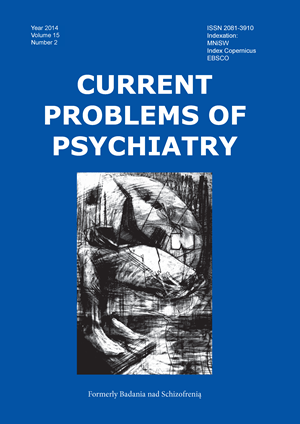Selected aspects of family dysfunctionality as compared to students’ activity on the Internet
Keywords:
dysfunctional family, students, the InternetAbstract
The aim of the study is to answer the following question: are there any dependencies, if any, between the selected forms of the young people’s activity on the Internet and the existence of conflicts with parents, experience of psychological violence from them and alcohol addiction of a family member.
The examined group comprised the total of 67 students aged 20-25 years, examined using the Internet Addiction Diagnostic Test (KBUI) designed by B. Pawłowska and E. Potembska and the Questionnaire designed by E. Potembska.
Conclusions. 1. Alcohol addiction of a family member is a variable, which is most strongly connected with the student activity on the Internet. 2. To a lesser degree than alcoholism, online activity is connected to experiencing physical violence within the family, whereas in the smallest degree to the prevalence of conflicts. 3. For students from dysfunctional families, online activity is a way to satisfy primarily the need for interaction and for self-esteem.
References
1. Rogers C. O stawaniu się sobą. Poznań: Dom Wydawniczy Rebis; 2002.
2. Badora B., Hipsz N., Gwiazda M. Młodzież o sobie: wartości, obyczajowość, grupy odniesienia. Młodzież 2010.CBOS. Opinie i diagnozy, 2011; 19: 103-123.
3. Ko C.H., Yen J.Y., Yen C.F., Chen C.S., Weng C.C., Chen C.C. The association between Internet addiction and problematic alcohol use in adolescents: the problem behavior model. Cyberpsychol Behav, 2008; 11(5): 571-576.
4. Lam L.T., Peng Z.W., Mai J.C., Jing J. Factors associated with Internet addiction among adolescents. Cyberpsychol Behav, 2009; 12(5): 551-555.
5. Wang H., Zhou X., Lu C., Wu J., Deng X., Hong L. Problematic internet use in high school students in Guangdong province, China. PLoS One, 2011; 6(5), e19660. doi:10.1371/journal.pone.0019660.
6. Park S.K., Kim J.Y., Cho C.B. (2008). Prevalence of Internet addiction and correlations with family factors among South Korean adolescents. Adolescence, 2008; 43(172): 895-909.
7. Wolak J., Mitchell K., Finkelhor D. Unwanted and wanted exposure to online pornography in a national sample of youth Internet users. Pediatrics, 2007;119(2): 247-257.
8. Chuchra M. Wróblewska M. Aktywność w sieci i relacje rodzinne młodzieży licealnej. Curr Probl Psychiatr, 2013; 14(3):141-151.
9. Pawłowska B., Potembska E. Właściwości psychometryczne Kwestionariusza do Badania Uzależnienia od Internetu (KBUI). Bad. Schizofr., 2009; 10:310-321.
10. Pawłowska B., Potembska E. Objawy zagrożenia uzależnieniem i uzależnienia od Internetu mierzonego Kwestionariuszem do Badania Uzależnienia od Internetu, autorstwa Pawłowskiej i Potembskiej u młodzieży polskiej w wieku od 13 do 24 lat. Curr Probl Psychiatr, 2011; 12(4): 439-442.
11. Woititz J.G. Dorosłe dzieci alkoholików. Warszawa: Akuracik; 2000.
12. Woititz J.G. Lęk przed bliskością. Gdańsk: Gdańskie Wydaw. Psychologiczne; 2000.
13. Chuchra M., Konowałek A. Percepcja siebie i rodziny u dorosłych dzieci alkoholików, Roczniki Teologiczne, 2005; 52(10): 169-182.
14. Kwon J.H. Toward the Prevention of Adolescent Internet Addiction. In: Young K.S., Nabucco de Abreu C. eds., Internet Addiction. A Handbook and Guide to Evaluation and Treatment. New Jersey; Willey: 2011, s.223-244.
15. Tichon J.G., Shapiro M.The process of sharing social support in cyberspace. Cyberpsychol Behav, 2003; 6(2):161-170.
16. Pawłowska B., Potembska E., Gleba E., Kalinowska-Tomala J., Krawczyński K. Uzależnienie od Internetu a relacje z rodzicami dziewcząt będących dziećmi alkoholików. Curr Probl Psychiatr, 2011;12(2):179-183.
17. Kołodziej B. Patologia życia rodzinnego i jej konsekwencje dla wzrostu i wychowania dziecka. Nauczyciel i Szkoła, 2003; 3/4: 81-106.
18. Martyn-Pisarska M. Znaczenie rodziny w opinii uzależnionych od alkoholu oraz członków ich rodzin. W: Jęczeń J., Stepulak M.Z. red., Wartość i dobro rodziny. Lublin; Wydawnictwo KUL: 2011, s.323-330.
19. Sheepersad S. Doping with Loneliness: Adolescent Online and Offline Behavior. Cyberpsychol Behav, 2004; 7(1):35-39.
20. Pawłowska B., Potembska E. Uzależnienie od Internetu u uczniów szkół średnich w kontekście czynników rodzinnych. Fam Med Prim Care Rev, 2011; 13(2): 226-228.
21. Griffiths M.D. Gry i hazard. Uzależnienie dzieci w okresie dorastania. Gdańsk; Gdańskie Wydawnictwo Psychologiczne: 2004.
22. Walther B., Morgenstern M., Hanewinkel R. Co-occurrence of Addictive Behaviors: Personality Factor Related to Substance Use, Gambling and Computer Gaming. Eur Addict Res, 2012; 18(4): 167-174.
23. Yen J.Y., Yen C.F., Chen C.C., Chen S.H., Ko C.H. Family factors of internet addiction and substance use experience in Taiwanese adolescents. Cyberpsychol Behav, 2007; 10(3): 323-329.
24. Alizadeh-Sahraee O., Khosravi Z., Yusefnejad M. The relationship of internet addiction with family functioning and mental health among Iranian students. Eur Psychiatr, 2011; 26(1) :1822-1822.
25. Kwiatkowska A., Ziołko E., Krysta K., Muc-Wierzgoń M., Krupka-Matuszczyk I. Impact of internet abuse on human relationships. Eur Psychiatr, 2007; 22(Suppl. 1): 192.
26. Young K.S., Yue X.D., Ying L. Prevalence Estimates and Etiologic Model of Internet Addiction. In: Young K.S., Nabucco de Abreu C. eds., Internet Addiction. A Handbook and Guide to Evaluation and Treatment. New Jersey; Willey: 2011, s. 3-18.


